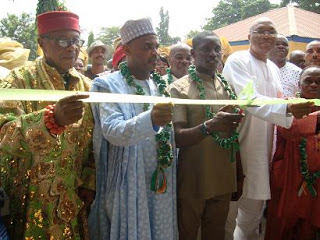
L-R Eze Njemanze, Ozuruigbo V of owerri, Director General of NCMM, Mallam Yusuf Abdallah, Imos State Commissioner for Culture and Tourism, Engr.Alex Ogwazuo and Hon.Ben Nwankwo, House Committee on Culture and Tourism, during the commissioning of the gallery
In the annals of history, owerri, the Imo state capital would remember Monday, December 19, 2011, as a day of remarkable cultural achievement. Sons and daughters of Igbo land gathered with pride to witness the opening of a permanent exhibition gallery for Igbo HOUSEHOLD, Ezi na ulo ndi Igbo.
Established by the National commission for Museums and Monuments (NCMM) the gallery has positioned the state to become a haven of culture, a centre point of practices and traditions with which the Igbo people are richly endowed.
The opening ceremony of sorts, was packed with many cultural activities, there was heavy drumming and dancing by town folks heralding the arrival of Igwe and other important personalities. In an exclusive chat with Escape, the Director General, NCMM, Mallam Yusuf Abdallah Usman said the Igbo Household exhibition is conceived to highlight the traditional family life system of the people which are gradually facing extinction.
“You know the household everywhere is where life is consciously nurtured and blossoms into the larger units, therefore the Igbo household as is found in every other culture is the beginning of social and other aspect of human development”
Usman said the commissioning is the beginning of a new dawn for the people of Imo state and an attempt for museums and monument to fulfill one of its mandates of propagating the uniqueness of the Nigeria culture, in promoting unity and peaceful co-existence among the people.
Imo’s custodian of culture and the Ozuruigbo V of owerri, Eze Njemanze told escape that the commissioning of the gallery is the long time opportunity Imo state has been waiting.
“Our culture and traditions are gradually facing extinction, the gallery will help to revive some of the things we have forgotten and will also teach our children, especially future generations what was done in the past by our ancestors”.
The Gallery situated in the National Museum, Owerri, has a collection of different art works that depicts the ways Igbo forefathers trod. It is a gallery that boasts of plethora of customs, traditions, and festivals that would appeal to the taste of tourists, evoking the cultural richness of indigenous people.
Several antiquities on installation would evoke deep reflections on the originality and uniqueness of practices by cultural forebears. The gallery can be said to be a place where one communes with the ancestors and a haven for relaxation.
However, it is said that, “a picture is worth a thousand words”, so a visit to the exhibition ground will bring culture lovers into greater knowledge of the extraordinary lives of people who existed in that part of Nigeria hundreds years ago. For instance, the ‘shrine inside the gallery is inscribed with the sacred writhing and hieroglyphics of the Igbo people. In Igbo traditional society, shrines are erected to provide place of worship, consultations, offerings and sacrifices to ancestors, deities and divinities, shrines were made according to the social experience of the society.
Other mnemonics on display are a carved female figure, clay pots, clay dishes, calabash cups, wooden rattle and fishing net.Visitors can also view a fertility pot (Ite Ola Okike) used in storing the ashes of umbilical cord of new born babies, which are said to be dropped in the pots probably for rituals.
The following are also on display: gong (Ekwe), man’s hut setting in the typical Igbo settlement pattern with items like sleeping animal hide couch, weapons and other personal belongings as machetes, hoes or carrying baskets (Abo) can be found inside. There are the wife’s hut, livestock pen, a yam barn, tools for hunting, contraptions for animal trapping and two sculptors that depicts how iron smelting and smiting was done in the olden days.
Other works include materials for palm oil processing, local tools for agriculture, musical instrument, cultural objects, instrument of warfare, pictures of morals and etiquette, body adornment and others.Pictures of morals and etiquette express the dignity and self assurances for which Igbo people are well known. Moral values and etiquette, regarded as conscience of society, are given high premium as it forms the major social norms and behavioral pattern of the people.
Also on display is the earliest form of trading system, known as trade by barter, which is the exchange of goods such as yam, cocoyam, metal and textile. This means of exchange was before the introduction of cowries and metal currencies.
The exhibition reveals the extraordinary creative range of Igbo people through diversity of objects that depicts their social life.
In case you are planning a visit to the state during this festive season or looking for a place to take your family to, few minutes’ drive to the city will create a lasting impression.
Comments
comments












Recent Comments